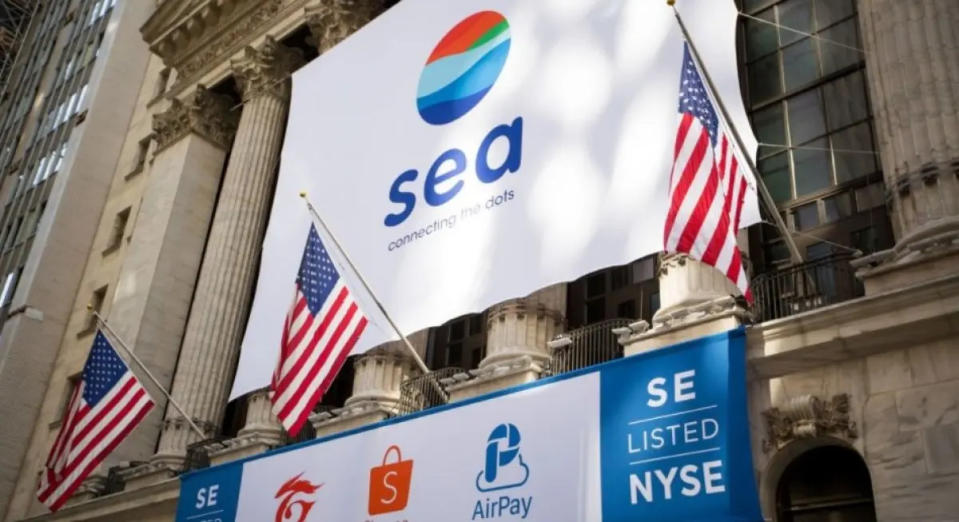Maybank and Citi reduce Sea’s TP to US$105 and US$145 respectively on EU retreat and global macro weakness

Sea’s current valuation is "attractive" and deemed "oversold": analysts
Maybank Securities analyst Samuel Tan has reduced NYSE-listed Sea Limited’s target price (TP) on the New York Stock Exchange (NYSE) to US$105 ($145.09) from US$140 previously following negative news on its exit from markets in France, Spain and India.
Tan has, however, kept Sea’s “buy” call.
Sea is a Singapore-founded internet company that has businesses in gaming, e-commerce and digital financial services, with subsidiaries including Garena and Shopee. Its share price has continued to fall with media reports of job cuts after its exit from the three markets, bringing its decline to 78% below its peak in October 2022.
The new sum-of-the-parts (SOTP)-based TP of US$105 still indicates a 36% upside even after deep cuts to Shopee’s enterprise value-to-sales (EV/S) from 3.0x to 1.5x on supply chain risks and after rolling forward Garena’s enterprise value to earnings before interest and taxes ratio (EV/EBIT) from 15.0x for FY2022 to 13.7x for FY2023.
In his report dated July 25, Tan believes Sea is testing its “bedrock valuation” of US$73.30 per share and could become a “deep-value buy” and a strong play on the normalisation of supply chains — which looks to be easing — once interest rates peak.
“With a more flexible ‘dynamic zero-Covid-19’ policy in place and progress in development of China’s AWcorna mRNA vaccine, a conclusion to supply chain issues could be on the horizon. Data indicates that supply chain issues are mostly centred around container and trucking capacity in Chinese ports and manufacturing is picking up,” he writes.
He notes that freight rates, based on the World Container Index (WCI) Composite, look to have
peaked, falling from a high of US$9,567 per forty-foot equivalent unit (FEU) in 3QFY2021 to US$7,051 3QFY2022, but still higher than the sub-US$2,000 per FEU levels pre-Covid.
Meanwhile, Citi Research analyst Alicia Yap has dropped her TP for Sea to US$145 from US$156 previously while also maintaining her “buy” call, citing global macro weakness, rising rate environment and strengthening of the US$ against most Asean currencies over the past few months.
“We believe foreign exchange (forex) headwinds are likely to weigh on year-on-year (y-o-y) growth for Sea’s US$ financials,” says Yap, who expects Sea to report its 2QFY2022 earnings around mid-August. She has lowered her 2QFY2022 estimated revenue by 5.8% to reflect the forecasted forex impact and slower consumption sentiment.
“We now model 2QFY2022 total GAAP revs of US$2.93 billion (+28% y-o-y and +1% q-o-q) vs. consensus estimate of US$3.04 billion. Our non-GAAP net loss is estimated to be US$686 million (-23% margin) or -US$1.23/share, vs. consensus of US$578.5 million or -US$1.005/share,” Yap writes.
GAAP refers to the generally accepted accounting principles, which are a set of accounting rules US-listed companies must follow.
“Looking into 2HFY2022, while e-commerce could gradually lapse on tough competition, with fears of global macro weakness sustaining, we conservatively lower our second-half e-commerce revenue growth and now model 62.5% y-o-y growth to US$8.3 bilion, which is lower than the low-end of guidance,” she adds.
Sea ‘well-placed’ to reduce dependence on China: Maybank Securities
Maybank’s Tan points out that although Sea claims direct cross-border sales from China make up “high single-digit to low-teens” of its gross merchandise volume (GMV), he notes that China-sourced items, which make up merchant partner inventories, are likely to account for more.
However, he also notes that Sea is “well-placed” to reduce its dependence on China if needed, by continuing to grow its presence in “emerging manufacturing hubs”, such as its retention of Poland and expansion into Mexico despite its retreat from the EU, Sea is positioned well to adapt to the trend of “regionalization”.
“Sea appears to be consolidating Latin American logistics networks with investments in 5 distribution centres in Brazil. Shopee’s Asean dominance, also a potential substitute for China manufacturing, should also help it pivot with shifts in supply chains,” adds Tan.
According to him, consumer indices across six of the 10 markets under Maybank’s study where Shopee is present are showing “upticks in consumer confidence”. The potential unbuckling of China’s supply chain, one source of inflation, is likely to lead to a “trampoline effect”, says Tan.
Sea’s current valuation ‘attractive’, deemed ‘oversold’: analysts
Citi’s Yap views Sea’s current valuation as “attractive despite factoring in headwinds”. By scaling back aggressive expansion and recent cost-cutting efforts, she adds that Shopee remains on track to achieve an adjusted positive EBITDA by end-2023 for Southeast Asia and Taiwan.
Maybank’s Tan concurs.
“Even after accounting for these risks in our valuation, we believe Sea is oversold and an opportunity for deep-value investing has opened up,” he writes.
“Precluding any negative geopolitical events, with signs of Chinese supply chain issues easing and a potential Chinese mRNA vaccine on the horizon, on top of a well position global presence to capture the new ‘regionalisation’ theme, we think Sea presents an opportunity to invest in a likely supply chain normalisation story.”
Further to his report, Tan has forecast a revenue CAGR of 26.5% for the FY2021 to FY2025, which is driven by ecommerce and digital financial services. The analyst also expects Sea to achieve break even in FY2024.
Key risks to Tan’s outlook include further geopolitical events affecting supply chains and forex effects from dollar appreciation.
Shares in Sea closed US$5.10 higher or 7.1% up at US$76.92 on the NYSE on July 27.
See Also:
Click here to stay updated with the Latest Business & Investment News in Singapore
Analysts estimate Keppel DC REIT's TP to hit within a range of $2.04 to $2.63
Get in-depth insights from our expert contributors, and dive into financial and economic trends

 Yahoo Finance
Yahoo Finance 